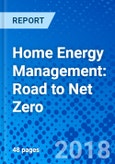1.0 Report Summary
1.1 Purpose of Report
1.2 Scope of Report
1.3 Key Questions Addressed
1.4 Research Approach/Sources
3.0 Zero Net Energy: An Idea Becomes Reality
3.1 Defining Zero Net Energy (ZNE)
3.2 Achieving ZNE: Energy Efficiency and Construction
4.0 California’s ZNE Program: Goals, Policies, Lessons
4.1 California’s Aggressive Goals
4.2 2019 Title 24, Part 6 Residential Building Efficiency Standards
4.3 Title 24, Part 6: Mandatory, Prescriptive and Performance
5.0 Beyond California
5.1 Policies, Codes, and Legislation
5.2 Consumers
5.3 Builders: Embracing and Differentiating
5.3.1 Company Profile: Meritage Homes
5.4 Partnerships
5.4.1 Project Profile: Mandalay Homes and sonnen
5.5 Obstacles
5.5.1 Low Energy Costs
5.5.2 Incentives and Availability of Products and Support
5.5.3 Budgets and Awareness
5.5.4 Utilities and Municipalities
6.0 Trends to Watch
6.1 Electrification and Factory Built
6.2 ZNE Communities and Existing Buildings
7.0 Market Opportunities
7.1 What Resonates with Home Buyers?
7.2 After the Purchase: Willingness to Buy and Upgrade
7.3 Smart Home Products
9.0 Appendix
9.1 Glossary:
9.2 Index
9.3 Image Sources
List of Figures
Figure 1 Importance of Having an Energy Efficient Home
Figure 2 Graphic Definition of Zero Net Energy
Figure 3 The Process of Achieving a Zero Net Energy Home
Figure 5 California’s Residential Electricity Use per Person
Figure 5 Impact of Building Standards on Home Energy Use
Figure 6 Daily Load Profile of Different Residential Customers
Figure 7 Load Profile of High Peak Usage with Battery Storage
Figure 8 Distributed Energy Familiarity, Perceived Value, and Affordability
Figure 9 Case Study of ZNE Multifamily Energy Use
Figure 10 California Energy Commission Residential Energy and Peak Load Forecasts 2013-2026
Figure 11 Energy Efficiency Consumer Segmentation
Figure 12 Average Monthly Electricity Bill
Figure 13 Planning and Partnerships for Advanced Energy Communities
Figure 14 Annual Spending Habits of Home Owners
Figure 15 Smart Home Device Ownership








